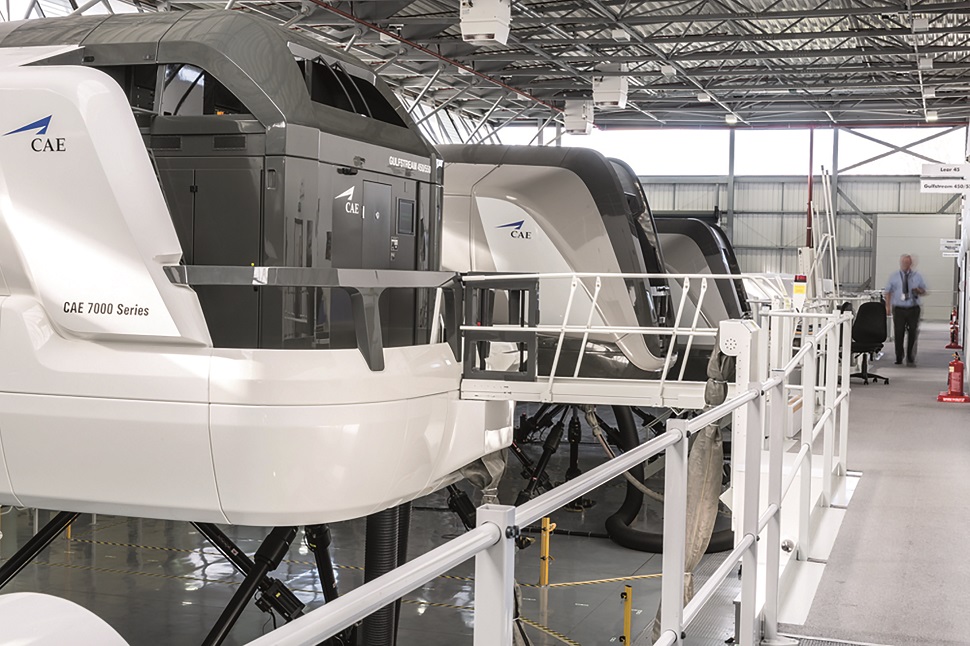CAE lands at this year’s BACE having significantly bolstered its business aviation presence in recent months. In March, the world’s largest flight training company and simulator manufacturer bought Bombardier’s Business Aviation Training arm from its Quebec neighbour for $645 million. The move added 12 full-flight simulators – in Dallas and Montreal – to CAE’s training network, taking its Bombardier machines to a total of 29. The acquisition also consolidated CAE’s status as dominant training provider for the Canadian airframer’s business jets.
CAE also expects to close a strategic partnership arrangement with investment firm Directional Aviation in November. As part of the deal, CAE will take a 50% stake in simulator training subsidiary Simcom, while Directional-owned subsidiaries Corporate Wings, Flairjet, Flight Options, and Sirio – which operate 175 business jets and turboprops – will use Simcom and CAE exclusively for their training under a 15-year agreement. Simcom, a specialist in general and business aviation training with two sites in Florida and a third in Arizona, is also buying five CAE full-flight simulators.

CAE
The two moves reflect a trend in the business aviation market for aircraft manufacturers and large operators to partner with one or other of the major providers for the bulk of their training needs. CAE’s main rival in the business aviation market is FlightSafety International, which has close relationships with both Gulfstream and Textron Aviation, although these are not exclusive.
In April this year, FlightSafety International and Textron subsidiary Tru Simulation formed a new company called FlightSafety Texron Aviation Training to provide training services for all Textron Aviation’s aircraft. FlightSafety has also been a partner of Gulfstream for more than 50 years, and the New York-based company is also the original factory-authorised training provider for Dassault.
CAE won some ground back by becoming the exclusive “Dassault-approved training provider” on the Falcon 5X, which was launched in 2013, a relationship which has continued after the twinjet’s replacement with the 6X. Now with Bombardier on board as well, Nick Leontidis, group president, civil aviation training solutions, says he wants to “create that relationship with all” the manufacturers. “You get a sense with this of the sort of investment we are making with the OEMs,” he adds.
The business aviation market shares many of the characteristics of the airline sector, where CAE is the leader in flightcrew training. One thing they have in common is the desperate need for pilots. This year, for the first time, CAE included business aviation in its 10-year forecast of pilot demand, estimating that the industry will need 40,000 new pilots by 2028 as a result of a growing market and an average 4% annual attrition due to flightcrew retiring or leaving the profession for other reasons, including joining airlines.
Other aspects are different. Leontidis describes business aviation as a “transactional market”. Unlike major airlines, even the largest business aviation companies do not tend to operate their own simulators. Aircraft are also “always moving around” creating the need for training facilities as close as possible to the customer. However, Leontidis also says it is a sector in which there is “a lot of loyalty”.
The 12 Bombardier simulators take CAE’s tally of training devices for business aircraft and helicopters to 85, including those it operates in joint ventures such as Emirates-CAE Flight Training in Dubai or with rotorcraft specialist Abu Dhabi Aviation, also in the United Arab Emirates. That is out of a total inventory of about 300 machines around the world across commercial, military and general aviation. The Bombardier Business Aviation Training acquisition also gave CAE some programmes that were not in its portfolio, such as the new Global 7500 flagship, deliveries of which began this year.
2019NBAA
Read all the latest news and information from the 2019 NBAA show on our dedicated page























